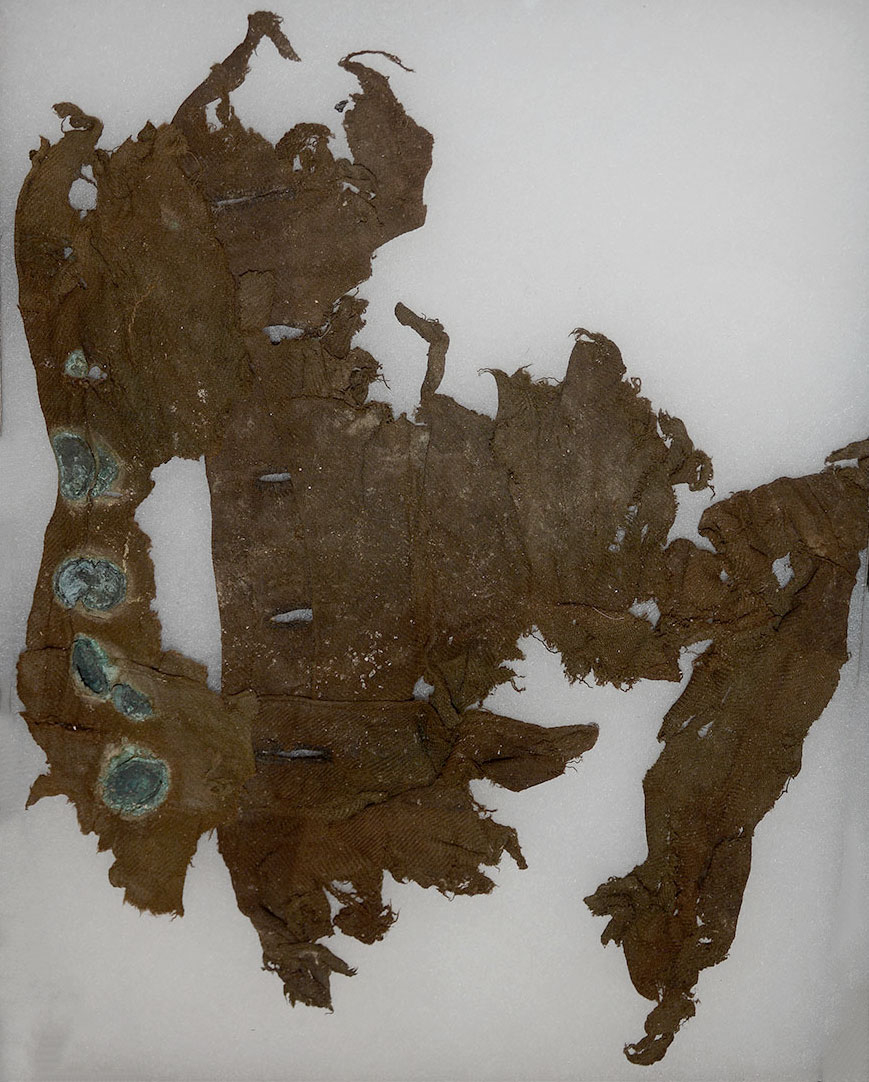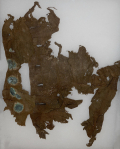site search
online catalog
PIECE OF AN INDIAN WAR M1872 FATIGUE BLOUSE FROM FORT PEMBINA, ND

$295.00
Quantity Available: 1
Item Code: 1052-578
Shipping: Determined by Method & Location of buyer
To Order:
Call 717-334-0347,
Fax 717-334-5016, or E-mail
This is a portion of the rare Model 1872 fatigue blouse. The pattern was a replacement for the old Civil War M1858 fatigue blouse (the 4-button sack coat,) made with the idea of giving the soldier greater freedom of movement and permitting the layering of garments underneath as desired in inclement weather. Like the older pattern they were produced in lined and unlined versions, but were fastened by nine buttons down the front and equipped with pockets in the tails as well as in the chest. They are extremely scarce, being regulation only from 1872 to 1874.
This piece comes from the excavations at Fort Pembina, ND, conducted on private property with the owner’s permission, where the soil conditions have preserved cloth and leather in remarkable condition, giving some real insight into the material culture of a small, frontier US Army post of the Indian Wars period. The condition is as shown with the blue fabric having shifted color to a light brown with white stains, showing holes, etc., and the brass buttons corroded. Their number and spacing, however, and the evident vertical pleats, clearly show what the garment was and the fabric is fairly solid and stable, making it a good study item and very displayable. The pattern was regulation only until the 1874 pattern came out, but like most army uniforms and gear was issued while the stocks lasted and photos of soldiers at frontier posts make clear there was often a mix of old, new and trial patterns as well as commercial variations, etc., at any given point in time.
Situated in the Red River Valley in North Dakota near the Canadian border, Fort Pembina was established in 1870 and in operation until 1895. Trading posts existed earlier in the area as part of the fur trade, and the first U.S. military post there was temporary- manned by a detachment of Minnesota troops in 1863-1864 following the 1862 Sioux uprising. In March 1870 a new fort was established south of the Pembina River and about 200 yards west of the Red River, completed by July and named in honor of Gen. George H. Thomas. The name was changed to Fort Pembina in September and the initial garrison consisted of two companies of the 20th US Infantry. Their main duty was to provide security for settlers worried about Sioux returning south from Canada, but the troops were more occupied with escorting boundary surveys along the Canadian border and preventing Fenian raids heading north into Canada.
The fort included enlistedmen’s barracks, officers’ quarters, guard house, ordnance storehouse, company kitchen, root house, laundress’s quarters, quarters for civilian employees, hospital and hospital servant’s house, a barn for the “hospital cow,” quartermaster and commissary offices and storehouse, stables, wagon shed, etc. The garrison reached peak strength in 1878 af 200, but the average was about 125 enlisted men and 8 officers. An October 1885 return listed 97 men, 2 field pieces, 1 mountain howitzer, 100 rifles, 19 pistols, 23 mules, and 9 wagons. By 1890 the post had just 23 men, and after an 1895 fire destroyed some 19 buildings it was decided to abandon the fort rather than rebuild, the last detachment left in September. The property was turned over to the Interior Department and later sold in 1902. [sr][ph:L]
~~~~~~~~~~~~~~~~~~~~~~~~~~~~~~~~~~~
THIS ITEM, AS WITH ALL OTHER ITEMS AVAILABLE ON OUR WEB SITE,
MAY BE PURCHASED THROUGH OUR LAYAWAY PROGRAM.
CLICK HERE FOR OUR POLICIES AND TERMS.
THANK YOU!
Inquire About PIECE OF AN INDIAN WAR M1872 FATIGUE BLOUSE FROM FORT PEMBINA, ND
For inquiries, please email us at [email protected]
Most Popular
Historical Firearms Stolen From The National Civil War Museum In Harrisburg, Pa »
Theft From Gravesite Of Gen. John Reynolds »
Selection Of Unframed Prints By Don Troiani »
Fine Condition Brass Infantry Bugle Insignia »
British Imported, Confederate Used Bayonet »
Scarce New Model 1865 Sharps Still In Percussion Near Factory New »
featured item
VERY SCARCE CONFEDERATE SWORD BELT WITH VIRGINIA BUCKLE
This buff leather, Model-1851 sword belt comes complete with sword hangers (one detached but present), all brass hardware, and a very fine Virginia State Seal belt plate. No shoulder strap present. The belt is of buff leather and shows honest use.… (1268-357). Learn More »
site search
Upcoming Events
May 16 - 18: N-SSA Spring Nationals, Fort Shenandoah, Winchester, VA Learn More »



